Genetic effects of Agropyron cristatum 2P chromosome translocation fragments in a wheat background
2023-01-06XUShiruiJlANGBoHANHaimingJlXiajieZHANGJinpengZHOUShenghuiYANGXinmingLlXiuquanLlLihuiLlUWeihua
XU Shi-rui ,JlANG Bo ,HAN Hai-ming ,Jl Xia-jie ,ZHANG Jin-peng ,ZHOU Sheng-hui ,YANG Xinming,Ll Xiu-quan,Ll Li-hui,LlU Wei-hua
1 National Key Facility for Crop Gene Resources and Genetic Improvement,Institute of Crop Sciences,Chinese Academy of Agricultural Sciences,Beijing 100081,P.R.China
2 Triticeae Research Institute,Sichuan Agricultural University,Chengdu 611130,P.R.China
Abstract Agropyron cristatum (2n=4x=28,PPPP) is a wild relative of common wheat which contains a large number of desirable genes that can be exploited for wheat improvement.Wheat–A.cristatum 2P alien translocation lines exhibit many desirable traits,such as small flag leaves,a high spikelet number and density,and a compact plant type.An agronomic trait evaluation and a genetic analysis were carried out on translocation lines and backcross populations of these lines carrying different translocation fragments.The results showed that a translocation fragment from 2PT-3 (2PL) reduced the length of the flag leaves,while translocation fragments from 2PT-3 (2PL) and 2PT-5 (2PL (0.60–1.00)) reduced the width of the flag leaves.A translocation fragment from 2PT-13 (2PS (0.18–0.36)) increased the length and area of the flag leaves.Translocation fragments from 2PT-3 (2PL) and 2PT-8 (2PL (0.86–1.00)) increased the density of spikelets.Translocation fragments from 2PT-7 (2PL (0.00–0.09)),2PT-8 (2PL (0.86–1.00)),2PT-10 (2PS),and 2PT-13 (2PS (0.18–0.36)) reduced plant height.This study provides a scientific basis for the effective utilization of wheat–A.cristatum translocation lines.
Keywords: wheat–Agropyron cristatum 2P chromosome translocation lines,flag leaf,spikelet density,genetic effects
1.lntroduction
Common wheat (Triticum aestivumL.,2n=6x=42,genomes AABBDD) is one of the world’s most important food crop species,and it is the grain crop with the second largest total output in the world after maize.Wheat yield and stress resistance have a narrow genetic basis,so enriching the genetic basis of cultivated varieties is necessary to improve wheat yield,quality and resistance to biotic and abiotic stresses (Trethowan and Mujeeb-Kazi 2008;Tester and Langridge 2010).
Flag leaf and spike-related traits are two of the main agronomic traits in wheat.The flag leaves are the main photosynthetic organs of wheat and contribute 45–58%of the photosynthetic performance during the grain-filling stage (Khaliqet al.2008).Wheat flag leaf traits include flag leaf length,flag leaf width,and flag leaf area.There are positive correlations among flag leaf area,thousandgrain weight,and spike weight (Liu K Yet al.2018).Duwayriet al.(1984) found that grain yield and kernel number per plant were reduced when the flag leaves were removed.Spike number per plant,grain number per spike and thousand-grain weight play decisive roles in determining wheat yield;while spike length affects the grain number per spike;and grain length,grain width,and the grain length-to-width ratio determine the thousandgrain weight (Caoet al.2019).The spike-related traits of wheat,such as spike length,spikelet number per spike,and spikelet density,are important factors in determining wheat yield (Jinet al.2020).Therefore,studying the characteristics of flag leaves and spikes is of great significance in the context of wheat production.
A large number of wild relatives of wheat have contributed to the improvement of cultivated wheat.In recent years,alien translocation lines have been obtained between wheat and many other species,such asAegilops speltoides(Petersenet al.2015),Secale cerealeL.(Renet al.2017),Thinopyrum elongatum(Tanakaet al.2017),Haynaldia villosa(Zhang R Qet al.2015),andPsathyrostachys huashanica(Kanget al.2011,2016).These alien translocation lines carry genes from the wild species that provide resistance to powdery mildew,leaf rust,stem rust,stripe rust,and other major wheat diseases,and they are widely used in wheat improvement.
Agropyron cristatum(2n=4x=28,PPPP) is a wild wheat relative that shows not only resistance to various diseases and stress but also increased numbers of tillers,spikelets,and florets,which improve wheat yield,so it is an important genetic resource for wheat improvement(Dewey 1984;Donget al.1992;Zhouet al.2017).Our team previously used ionizing radiation to obtain a batch of wheat–A.cristatum2P (Liet al.2016),6P (Songet al.2013),and 7P (Luet al.2016) translocation lines.This study provides a material basis for the analysis of the genetic effects of the various wheat–A.cristatumtranslocation lines.A previous study by our lab revealed thatA.cristatumchromosome 6P carries two genes related to an increased grain number per spike,which are located in the 6PL (0.72–1.00) and 6PL pericentromeric regions (Zhanget al.2017,2018).In addition,the 6P chromosome fragment carries loci for enhanced thousand-grain weight.Furthermore,genes conferring high grain weight and grain length are present on the short arm of chromosome 7P near the centromere region(S1–S3) (Luet al.2016).However,the genetic effects of different translocation fragments of chromosome 2P have not been reported thus far.
The purposes of this study were: (1) to investigate the main agronomic traits of eight different wheat–A.cristatum2P translocation lines;(2) to identify specific molecular markers,investigate agronomic traits,and perform a genetic analysis of backcross populations of the various translocation lines;and (3) to provide a scientific basis for the effective use of the desirable genes carried by chromosome 2P ofA.cristatumfor wheat genetic improvement.
2.Materials and methods
2.1.Plant materials
Triticum aestivum cv.Fukuhokomugi (2n=42,AABBDD,Fukuho for short) was used as the receptor for additional lines and translocation lines;Agropyron cristatumZ559(2n=4x=28,PPPP);and wheat–A.cristatum2P disomic addition line II-9-3 (2n=44).The wheat–A.cristatumtranslocation lines 2PT-3 (4DS.2PL),2PT-5 (3BS.3BL-2PL(0.60–1.00)),2PT-6 (6AS.6AL-2PL (0.37–0.66)),2PT-7(4DS-2PL (0.00–0.09)),2PT-8 (4AS.4AL-2PL (0.86–1.00)),2PT-10 (2PS.1AL),2PT-13 (7BL.7BS-2PS (0.18–0.36)),and 2PT-14 (7BL.7BS-2PS (0.10–0.36)) derived from II-9-3 were induced by60Co-γ ray irradiation (Liet al.2016) (Figs.1 and 2).These translocation lines and the backcross populations of the receptor Fukuho were used for the analysis of translocation fragment effects and were provided by the Center of Crop Germplasm Resources Research in the Institute of Crop Sciences,Chinese Academy of Agricultural Sciences (CAAS),Beijing,China.
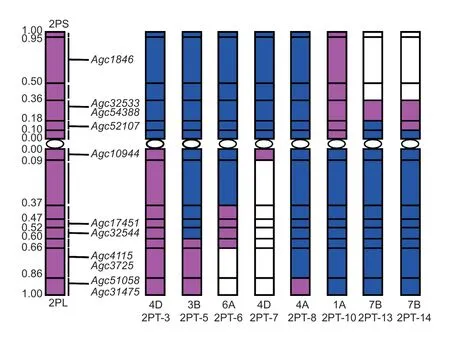
Fig.1 Chromosome diagrams of the translocated 2P chromosome.The left map shows the schematic diagram of Agropyron cristatum chromosome 2P.Pink and blue colors represent A. cristatum 2P and wheat chromosomal segments,respectively.

Fig.2 Genomic in situ hybridization (GISH) patterns of four wheat–Agropyron cristatum translocation lines.A–D are GISH identifications of 2PT-3,2PT-5,2PT-13,and 2PT-14,respectively.Arrows show the translocated chromosomes.
2.2.Chromosome preparation and genomic in situ hybridization (GlSH) detection
Seeds were soaked in water in Petri dishes with doublelayered moistened filter paper at 24°C for 24 h.Roots were sampled when they were approximately 1.5–2.0 cm long,and excised root tips were treated with nitrous oxide gas for 2 h.Treated root tips were fixed in 90% acetic acid for 8 min and then stored in 70% ethanol at 20°C until use.Chromosome preparation was performed by referring to the method of Hanet al.(2006).Cytological observations were conducted using a BX51 Olympus Phase Contrast Microscope (Olympus Corp.,Tokyo,Japan),and images were obtained with a digital camera.When necessary for GISH detection,the slides were fixed using ultraviolet light in a TL-2000 Ultraviolet Translinker (Japan) for 1 min.
GISH was conducted to detect alien chromosomes in the common wheat background.Total genomic DNA ofA.cristatumZ559 and Fukuho was extractedviathe modified CTAB method (Gillet al.1991).Fluorescent probe labeling of the total genomic DNA ofA.cristatumwas conducted with Texas red-5-dCTP (Hanet al.2006).Cytological images were observed and captured with a ZEISS AX10 fluorescence microscope.
2.3.Molecular marker analysis
Agropyron cristatum2P-specific sequence-tagged site (STS) markers (Table 1) located in different bins of the 2P chromosome were developed according to the expressed sequence tag (EST) sequences of theA.cristatumtranscriptome sequences and used to detect the presence or absence of 2P chromosomal segments in these materials (Zhang J Pet al.2015;Liet al.2017).

Table 1 Primer sequences of the Agropyron cristatum 2P-specific sequence-tagged site (STS) markers for detecting the plants of different translocation line backcross populations
PCR amplification was performed as described by Liet al.(2017).The amplification reactions were conducted in a total volume of 10 μL consisting of 1.0 μL of 10×buffer,1.0 μL of forward primer (2 μmol L–1),1.0 μL the reverse primer (2 μmol L–1),2 μL of dNTPs (10 mmol L–1),0.2 μL ofTaqDNA polymerase (2 U μL–1),0.3 μL of template DNA (50 ng μL–1) and 5.5 μL of ddH2O.
The cycling conditions were as follows: 94°C for 5 min followed by 35 cycles of 94°C for 1 min,59°C for 1 min,and 72°C for 1 min,followed by a final 10-min extension at 72°C.The amplified products were separated by electrophoresis on a polyacrylamide gel with an acrylamide concentration of 8% and were visualized by silver staining.
2.4.Evaluation of agronomic traits
The wheat–A.cristatum2P translocation line BC2F2population was planted in Xinxiang,Henan Province,China,in 2017 and 2018 in accordance with a completely randomized block design with three replicates.The disomic addition line II-9-3 and the wheat receptor parent Fukuho were used as controls.The planting rows were 2 m in length,with 0.3 m between rows,and 20 grains were evenly distributed in each row during planting.Individual plants were selected from both the disomic addition line II-9-3 and the receptor parent Fukuho.All individuals in the backcross populations of translocation lines 2PT-3,2PT-5,2PT-6,2PT-7 2PT-8,2PT-10,2PT-13,and 2PT-14 were evaluated.The genetic effects of the translocation fragments were analyzed and validated in the backcross populations obtained from these lines.At the filling stage,the lengths and widths of the flag leaves were evaluated in all the materials.At the physiological maturity stage,plant height,spike length,spikelet number per spike,grain number per spike,fertile tiller number,and thousand-grain weight were evaluated in all the materials.The spikelet density was calculated as follows: The spikelet density=(Spikelet number per spike–1/Spike length)×10.The standard methods of investigation were performed with reference to the Descriptors and Data Standard for Wheat (Triticum aestivumL.) (Liet al.2006).The flag leaf area was calculated as: (Flag leaf length×Flag leaf width)×75%(Liu K Yet al.2018).The data were analyzed using the Statistical Analysis System version 9.4 (SAS Institute Inc.,Cary,NC,USA).
3.Results
3.1.Evaluation of the agronomic traits of different translocation lines
The flag leaf traits of disomic addition line II-9-3,the common wheat cultivar Fukuho,and eight 2P translocationlines were evaluated at the grain-filling stage (Fig.3);and after the plants were harvested,their agronomic traits were evaluated (Fig.4).The main agronomic traits of the eight 2P translocation lines are shown in Table 2.

Table 2 Main agronomic traits of the different translocation lines1)
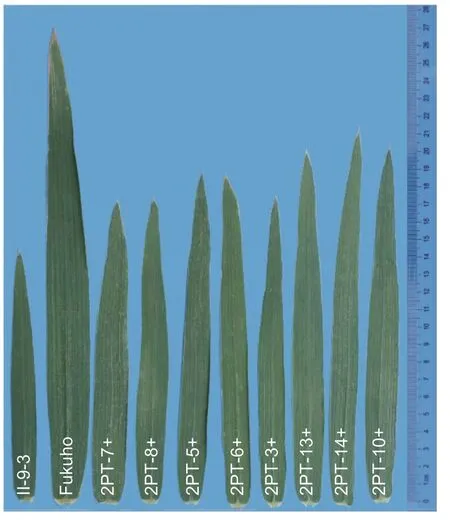
Fig.3 Flag leaf morphology of wheat–Agropyron cristatum 2P disomic addition line II-9-3,Fukuho and eight translocation lines.

Fig.4 Spike morphology of wheat–Agropyron cristatum 2P disomic addition line II-9-3,Fukuho and eight translocation lines.A–J,II-9-3,Fukuho,2PT-3,2PT-7,2PT-6,2PT-5,2PT-8,2PT-10,2PT-13,and 2PT-14,respectively.
The main agronomic traits of wheat–A.cristatumdisomic addition line II-9-3,the Fukuho cultivar,and the eight wheat–A.cristatumtranslocation lines were compared.The results showed that the flag leaf length,width,and area,as well as grain number per spike,spike length,plant height,fertile tiller number and thousand-grain weight of II-9-3 all presented significantly lower values than those of the receptor parent Fukuho,whereas the spikelet density of II-9-3 was significantly higher than that of Fukuho.These results indicated that chromosome 2P ofA.cristatumaffects all of these traits.The flag leaf traits,spike length,and plant height of these translocation lines were different from those of Fukuho.
3.2.Analysis of translocation lines and backcross populations using molecular markers
Agropyron cristatumZ559 and II-9-3 were used as positive controls,whereas Fukuho was used as a negative control.Agropyron cristatum2P-specific STS markers were used to determine the presence or absence of 2P chromosomal segments in the backcross populations of the BC2F2generations of translocation lines 2PT-3,2PT-5,2PT-6,2PT-7,2PT-8,2PT-10,2PT-13,and 2PT-14 (Fig.5;Table 3).Some plants with positive markers were detected by GISH and contained the corresponding translocation fragments,and the statistics for the transmission rate of translocation fragments were calculated (Fig.6).In the F2population,theoretically,if positive strains accounted for three-fourths of individuals and negative strains accounted for one-fourth,it would mean that the P chromosome fragment was 100% transmitted.The actual transmission rates of different translocation fragments were between 63.55 and 93.05%.These transmission rates were lower than the theoretical value,which is consistent with previous reports.The plants showing positivity and negativity for specific markers were recorded for the further analysis of their agronomic traits.
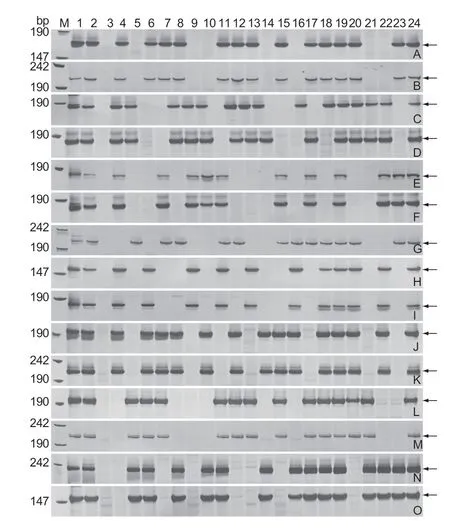
Fig.5 Amplification patterns of the Agropyron cristatum 2P translocation lines using 15 sequence-tagged site (STS) markers specific for the A.cristatum 2P chromosome.M,pUC19 DNA/MspI (HpaII);1,A.cristatum accession Z559; 2,II-9-3;3,Fukuho;4–24,the isolates of different populations.A and B,detection of 2P segments of the 2PT-10 backcross population using the primers Agc1846 and Agc52107,respectively;C and D, detection of 2P segments of the 2PT-14 backcross population using the primers Agc32533 and Agc54388,respectively;E and F, detection of 2P segments of the 2PT-13 backcross population using the primers Agc32533 and Agc54388,respectively;G, detection of 2P segments of the 2PT-7 backcross population using the primer Agc10944;H and I, detection of the 2P segments of 2PT-6 backcross population using the primers Agc17451 and Agc32544,respectively;J and K, detection of the 2P segments of 2PT-5 backcross population using the primers Agc4115 and Agc3725,respectively;L and M, detection of the 2P segments of 2PT-3 backcross population using the primers Agc4115 and Agc3725,respectively;N and O, detection of the 2P segments of 2PT-8 backcross population using the primers Agc51085 and Agc31475,respectively.Arrows indicate the diagnostic bands.

Fig.6 Genomic in situ hybridization (GISH) patterns of eight backcross populations of translocation lines.A–H,GISH identifications of backcross populations of 2PT-3,2PT-5,2PT-6,2PT-7,2PT-8,2PT-10,2PT-13,and 2PT-14,respectively.Arrows show the translocated chromosomes.
3.3.Analysis of flag leaf traits in backcross populations of translocation lines
Duncan’s multiple-range test revealed significant differences in flag leaf length and width among the backcross populations of different wheat–A.cristatum2P translocation lines (Table 4).
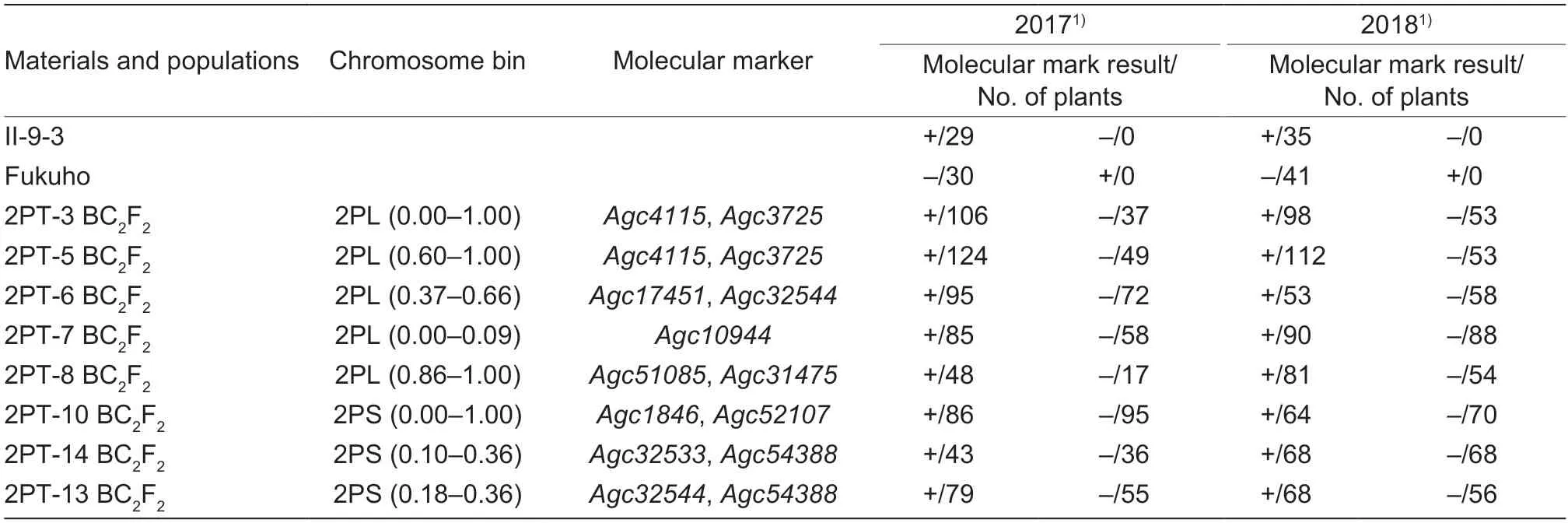
Table 3 Molecular marker analysis of different 2P translocation lines and their backcross populations
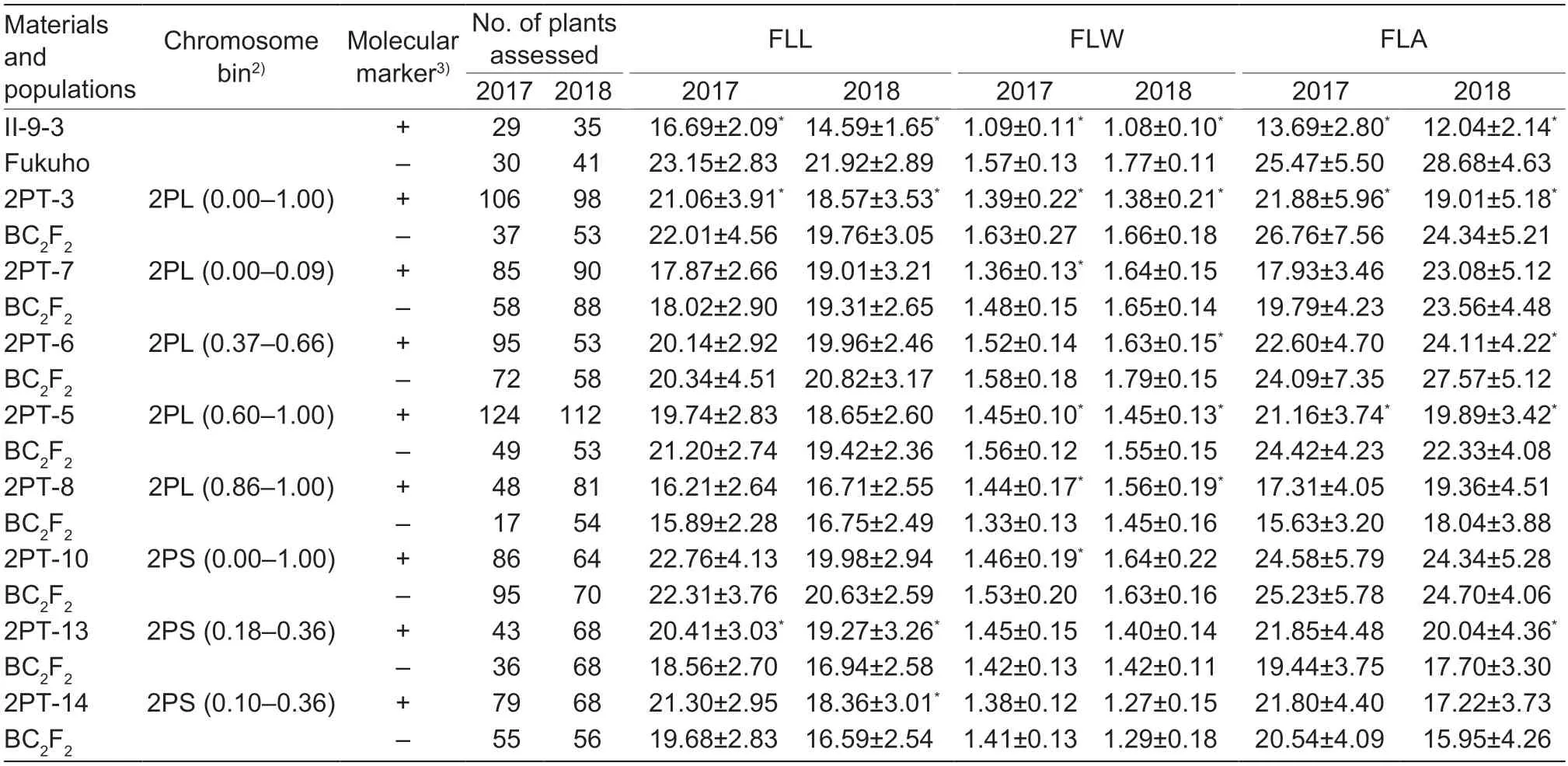
Table 4 Comparison of flag leaf characters among wheat–Agropyron cristatum 2P translocation lines and their parents1)
The molecular marker and flag leaf trait analyses of the long arm backcross population of 2PT-3 in 2017 and 2018 revealed mean flag leaf lengths of 21.06 and 18.57 cm,respectively,in positive plants;while the mean flag leaf widths of these plants were 1.39 and 1.38 cm,respectively,and the mean flag leaf areas were 20.84 and 18.10 cm2,respectively.The mean flag leaf lengths of the plants that were not carrying translocation fragments were 22.01 and 19.76 cm in 2017 and 2018,respectively;while the flag leaf widths were 1.63 and 1.66 cm,respectively,and the flag leaf areas were 25.49 and 23.18 cm2,respectively.Thus,the flag leaf lengths,widths,and areas of the 2PT-3 (2PL (0.00–1.00)) positive plants were significantly lower than those of the negative plants in both 2017 and 2018.
Flag leaf trait analyses of four long arm translocation lines,2PT-5 (2PL (0.60–1.00)),2PT-6 (2PL (0.37–0.66)),2PT-7 (2PL (0.00–0.09)),and 2PT-8 (2PL (0.86–1.00)),showed that the flag leaf areas and flag leaf widths of 2PT-5 positive plants were significantly smaller than those of 2PT-5 negative plants.Statistical analysis showed that 2PT-5 carried the bin of fragment length 0.60–1.00 of 2PL,which reduced the width and area of the flag leaf;while 2PT-8 carried the bin of fragment length 0.86–1.00 of 2PL,which increased the flag leaf width.
There was no significant difference in flag leaf area between the positive and negative plants in any of the backcross populations of the different short arm translocation lines.
3.4.Analysis of spike traits in the backcross populations translocation lines
The results of the analysis of spike traits in the backcross populations of the translocation lines are shown in Table 5.The results from 2017 and 2018 suggested that the spike lengths of 2PT-3 positive plants were significantly shorter than those of 2PT-3 negative plants.The spikelet densities of 2PT-3 positive and 2PT-10 positive plants were significantly higher than those of the negative plants in the two study years.The results showed that the 2PL translocation fragment of 2PT-3 could reduce spike length and increase spikelet density.The spikelet densities of 2PT-8 translocation fragment positive plants were higher than those of negative plants in both study years,and the difference was significant in 2017,which indicated that the 2PT-8 fragment carrying the bin of fragment length 0.86–1.00 of 2PL increased spikelet density.The grain numbers per spike of 2PT-6 translocation fragment positive plants were significantly higher than those of negative plants in both study years.The other translocation lines did not show significant correlations of their spike traits.
3.5.Analysis of plant height,tiller number,and thousand-grain weight in the backcross populations of translocation lines
The results of the analysis for other agronomic traits in the backcross populations of the translocation lines are shown in Table 6.In the populations of the 2PT-7 and 2PT-10 translocation lines in 2017 and 2018,the plant heights of positive plants were significantly lower than those of negative plants.In the populations of the 2PT-8 and 2PT-13 translocation lines,the plant heights of positive plants were lower than those of negative plants,and the differences were significant in 2018.These results showed that 2PT-7 and 2PT-8 contained the bins of fragment lengths 0.00–0.09 and 0.86–1.00,respectively,of 2PL,while 2PT-10 contained the whole 2PS arm,and 2PT-13 contained the bins of fragment length 0.18–0.30 of 2PS.All of them reduced plant height.

Table 6 Comparison of whole plant characters among wheat–Agropyron cristatum 2P translocation lines and their parents1)
The wheat–A.cristatum2P disomic addition line II-9-3 and positive plants from the segregated populations of translocation lines 2PT-3,2PT-6,2PT-8,2PT-10,and 2PT-13 all showed trends of lower fertile tiller trait values relative to those of negative plants.
Although thousand-grain weight was lower in the wheat–A.cristatum2P disomic addition line II-9-3 and the long arm translocation line 2PT-3 than in Fukuho,the thousand-grain weight of the short arm translocation line 2PT-10 was increased.These results indicate that the 2P short arm translocation line can be utilized to increase thousand-grain weight.
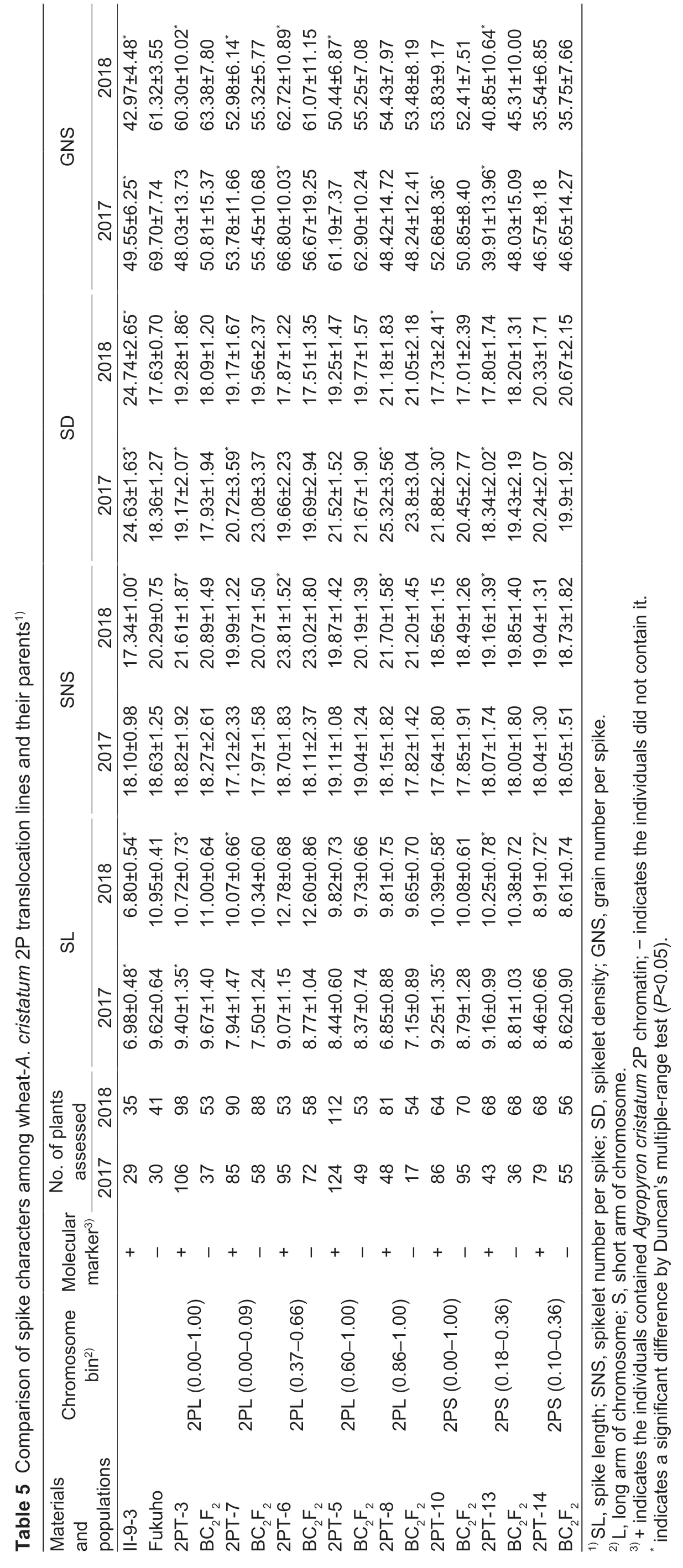
The wheat–A.cristatum2P translocation lines originated from disomic addition line II-9-3 and were obtained through multiple backcrosses with Fukuho.Fukuho has a compact type,and the plant type of the translocation lines was improved by backcrossing with Fukuho,resulting in a compact plant type for the translocation lines carrying chromosome 2P.
4.Discussion
4.1.Genetic effects of different wheat–A.cristatum 2P translocation lines
The narrow genetic base of common wheat limits the improvement of wheat yield and quality,so the introduction of heterogeneous chromosome fragments is a useful approach for improving the agronomic characteristics in wheat (Qiet al.2016).The P-genome ofA.cristatumconfers various desirable traits that can be used for wheat improvement,and analyzing the genetic effects of different chromosome translocation fragments is of great significance for application in polyploid plants.Chromosome 2P ofA.cristatumconfers the characteristics of leaf rust resistance,powdery mildew resistance,and a compact plant type.The powdery mildew and leaf rust resistance genes of the 2P translocation lines are located in the 2PL (0.66–0.86)segment (Liet al.2017;Jianget al.2018).When disease resistance is controlled by a single dominant gene,the effects of the addition line and translocation line are often consistent,while the effects of the addition of the whole chromosome and translocation fragments are often different for quantitative traits.In this study,the analysis of agronomic traits and molecular markers in different backcross populations of 2P translocation lines showed that the translocation fragment from 2PT-3 (2PL) in the translocation line reduced flag leaf traits and spike length,but increased spikelet density.Translocation fragments from 2PT-5 (2PL (0.60–1.00))reduced flag leaf width and flag leaf area.Translocation fragments from 2PT-8 (2PL(0.86–1.00)) increased spikelet density and flag leaf width,but reduced plant height.Furthermore,translocation fragments from 2PT-7 (2PL (0.00–0.09),2PT-10 (2PS),and 2PT-13 (2PS (0.18–0.36)) could also reduce plant height.The effects of the translocationfragments of the translocation lines 2PT-6 and 2PT-10 on the grain number per spike and thousand-grain weight,respectively,are different from those of the addition line II-9-3,which may be because the whole chromosome of the addition line is introduced into wheat in this case,and the long and short arms of different segments may have different effects.In addition,the effect of the translocation segment of the translocation line is also affected by the replaced wheat chromosome segment;therefore,the effect of a translocation line segment is different from that of the whole chromosome.The translocation line is genetically stable,and the introduction of alien genes into wheat is more effective than introduction into the addition line.The effects of irradiation induction on changes in the wheat background can be reduced and weakened by multiple backcrosses.
4.2.Breeding availability of different wheat–A.cristatum 2P translocation lines
Flag leaves are an important photosynthetic organ in wheat,and the photosynthesis rate of flag leaves affects the grain filling and grain yield of wheat after the heading stage.In addition,there are also correlations between spike-related traits and wheat yield.Therefore,it is of great practical significance to conduct genetic research on the agronomic traits related to both flag leaves and spike yield of wheat.In nature,the grain weight per spike increases significantly with increasing flag leaf area.Research has shown that wheat yield is positively correlated with flag leaf width and area,but negatively correlated with flag leaf length (Wuet al.2016).Optimal flag leaf sizes and shapes in wheat can reduce water loss and result in higher yields (Yanget al.2016).Furthermore,the numbers of major,environmentally stable,and verified genetic loci for flag leaf-related traits recorded to date are limited (Liu K Yet al.2018;Liu Y Xet al.2018;Maet al.2020).Our recent research showed thatA.cristatumchromosome 1P is associated with a small flag leaf area.In the future,the genes controlling flag leaf traits carried by chromosomes 1P and 2P will be compared.In this study,the flag leaf length of Fukuho was too long,and that of II-9-3 was too short,neither of which are favorable characteristics for breeding.However,the flag leaf traits of the obtained translocation lines 2PT-3 and 2PT-5 were improved relative to those of the donor parents.
Spikelet number and grain number per spike are important factors for determining wheat yield,and the grain number per spike is affected by the grain number per spikelet and the spikelet number per spike (Dinget al.2022).The evaluation of the spike-related traits (spikelet number,grain number,spike length,and spike density) in wheat indicated that wheat–A.cristatum2P translocation lines 2PT-3 and 2PT-8 carry genes controlling spikelet density,and that translocation line 2PT-3 also carries genes controlling spikelet number.The high values of spike-related traits of these two translocation lines are more suitable for growth in the wheat areas of North China.Translocation lines 2PT-6 and 2PT-10 showed increases in the number of grains per spike,but spikerelated traits were susceptible to environmental impacts,the environmental effects of different years,and the replacement of wheat chromosome fragments,possibly leading to the lack of any significant differences between the two years of data.
When larger alien chromosome fragments carrying target genes are transferred to wheat,undesirable traits can be introduced simultaneously (Liet al.2007).The translocation line 2PT-3 carried bins of 2PL with a fragment length of 0.00–1.00,so the translocation fragment was large,and its thousand-grain weight and fertile tiller number were significantly reduced;but these characteristics may be related to linkage drag.The bins of fragment length 0.86–1.00 of the 2PL chromosome carried by translocation line 2PT-8 is small,and this line showed improved comprehensive agronomic traits and a suitable flag leaf length,flag leaf width,and flag leaf area.Spikelet number,spike density,and grain number per spike were increased in this line,indicating that the smaller translocation fragment of translocation line 2PT-8 has limited linkage drag.Thus,creating translocation lines with smaller fragments that carry the desired genes is beneficial for reducing linkage drag.
5.Conclusion
We investigated the main agronomic traits of eight different wheat–A.cristatum2P translocation lines and backcross populations,and performed specific molecular marker detection,agronomic trait investigation,and genetic analysis.The results showed that a translocation fragment from 2PT-3 reduced the length and width of the flag leaves,while translocation fragments from 2PT-3 increased the density of spikelets.The translocation fragments from 2PT-5 reduced the width of the flag leaves.The translocation fragments from 2PT-8 increased spikelet density and flag leaf width,but reduced plant height.The translocation fragment from 2PT-13 increased the length and area of the flag leaves,but reduced plant height.Translocation fragments from 2PT-7 and 2PT-10 reduced plant height.Creating translocation lines is an effective way to transfer desirable genes from wild relatives into wheat,and the evaluation of the genetic effects of different translocation fragments by using backcross populations may provide guidance and a scientific basis for the effective utilization of translocation lines in wheat breeding programs.
Acknowledgements
This research was supported by grants from the National Natural Science Foundation of China (32272083) and the National Key Research and Development Program of China (2016YFD0100102).
Declaration of competing interest
The authors declare that they have no conflict of interest.
杂志排行
Journal of Integrative Agriculture的其它文章
- Advances in studies on the physiological and molecular regulation of barley tillering
- Antioxidant lignans sesamin and sesamolin in sesame (Sesamum indicum L.): A comprehensive review and future prospects
- TaABI19 positively regulates grain development in wheat
- Grain yield,nitrogen use efficiency and physiological performance of indica/japonica hybrid rice in response to various nitrogen rates
- Border effects of the main and ratoon crops in the rice ratooning system
- Agronomic management practices in dryland wheat result in variations in precipitation use efficiency due to their differential impacts on the steps in the precipitation use process
